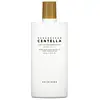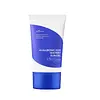What's inside
What's inside
 Key Ingredients
Key Ingredients

 Benefits
Benefits

 Concerns
Concerns

 Ingredients Side-by-side
Ingredients Side-by-side

Centella Asiatica Extract 35.8%
CleansingCyclopentasiloxane
EmollientZinc Oxide
Cosmetic ColorantButyloctyl Salicylate
Skin ConditioningTitanium Dioxide
Cosmetic ColorantPropanediol
SolventBenzotriazolyl Dodecyl P-Cresol
UV AbsorberCoptis Chinensis Root Extract
AntioxidantPEG-10 Dimethicone
Skin ConditioningNiacinamide
SmoothingDisteardimonium Hectorite
StabilisingButylene Glycol
HumectantMagnesium Sulfate
1,2-Hexanediol
Skin ConditioningCaprylic/Capric Glycerides
EmollientDimethicone
EmollientVp/Hexadecene Copolymer
Polymethylsilsesquioxane
Aluminum Hydroxide
EmollientStearic Acid
CleansingSorbitan Sesquioleate
EmulsifyingTriethoxycaprylylsilane
Dimethicone Crosspolymer
Emulsion StabilisingDimethicone/Vinyl Dimethicone Crosspolymer
Skin ConditioningDextrin
AbsorbentTheobroma Cacao Extract
Skin ConditioningPelargonium Graveolens Flower Oil
MaskingWater
Skin ConditioningCitrus Aurantium Bergamia Fruit Oil
MaskingBetaine
HumectantScutellaria Baicalensis Root Extract
AstringentPolygonum Cuspidatum Root Extract
AntioxidantGlycyrrhiza Glabra Root Extract
BleachingCamellia Sinensis Leaf Extract
AntimicrobialSodium Hyaluronate
HumectantRosmarinus Officinalis Leaf Extract
AntimicrobialChamomilla Recutita Flower Extract
MaskingRosa Damascena Flower Oil
MaskingPentylene Glycol
Skin ConditioningMadecassoside
AntioxidantCitronellol
PerfumingGeraniol
PerfumingLinalool
PerfumingCentella Asiatica Extract 35.8%, Cyclopentasiloxane, Zinc Oxide, Butyloctyl Salicylate, Titanium Dioxide, Propanediol, Benzotriazolyl Dodecyl P-Cresol, Coptis Chinensis Root Extract, PEG-10 Dimethicone, Niacinamide, Disteardimonium Hectorite, Butylene Glycol, Magnesium Sulfate, 1,2-Hexanediol, Caprylic/Capric Glycerides, Dimethicone, Vp/Hexadecene Copolymer, Polymethylsilsesquioxane, Aluminum Hydroxide, Stearic Acid, Sorbitan Sesquioleate, Triethoxycaprylylsilane, Dimethicone Crosspolymer, Dimethicone/Vinyl Dimethicone Crosspolymer, Dextrin, Theobroma Cacao Extract, Pelargonium Graveolens Flower Oil, Water, Citrus Aurantium Bergamia Fruit Oil, Betaine, Scutellaria Baicalensis Root Extract, Polygonum Cuspidatum Root Extract, Glycyrrhiza Glabra Root Extract, Camellia Sinensis Leaf Extract, Sodium Hyaluronate, Rosmarinus Officinalis Leaf Extract, Chamomilla Recutita Flower Extract, Rosa Damascena Flower Oil, Pentylene Glycol, Madecassoside, Citronellol, Geraniol, Linalool
Water
Skin ConditioningButylene Glycol
HumectantEthylhexyl Salicylate
UV AbsorberHomosalate
Skin ConditioningDibutyl Adipate
EmollientNiacinamide
SmoothingBis-Ethylhexyloxyphenol Methoxyphenyl Triazine
Skin ConditioningCyclopentasiloxane
EmollientMethylene Bis-Benzotriazolyl Tetramethylbutylphenol
UV FilterPolysilicone-15
UV FilterDiethylamino Hydroxybenzoyl Hexyl Benzoate
UV Filter1,2-Hexanediol
Skin ConditioningPentylene Glycol
Skin ConditioningPinus Pinaster Bark Extract
AntioxidantCeramide NP
Skin ConditioningCentella Asiatica Extract
CleansingGlycerin
HumectantPortulaca Oleracea Extract
Skin ConditioningHouttuynia Cordata Extract
Skin ConditioningOlea Europaea Fruit Oil
MaskingFicus Carica Fruit Extract
HumectantSodium Hyaluronate
HumectantCeteth-10
EmulsifyingHydrogenated Lecithin
EmulsifyingDecyl Glucoside
CleansingPropanediol
SolventTocopherol
AntioxidantAstaxanthin
Skin ConditioningHyaluronic Acid
HumectantSodium Hyaluronate Crosspolymer
HumectantAscorbyl Propyl Hyaluronate
Skin ConditioningHydrolyzed Hyaluronic Acid
HumectantHydroxypropyltrimonium Hyaluronate
Acrylates/C10-30 Alkyl Acrylate Crosspolymer
Emulsion StabilisingSodium Acetylated Hyaluronate
HumectantHydrolyzed Sodium Hyaluronate
Skin ConditioningAdenosine
Skin ConditioningXanthan Gum
EmulsifyingCetyl PEG/PPG-10/1 Dimethicone
EmulsifyingTromethamine
BufferingCarbomer
Emulsion StabilisingPropylene Glycol
HumectantEthylhexylglycerin
Skin ConditioningWater, Butylene Glycol, Ethylhexyl Salicylate, Homosalate, Dibutyl Adipate, Niacinamide, Bis-Ethylhexyloxyphenol Methoxyphenyl Triazine, Cyclopentasiloxane, Methylene Bis-Benzotriazolyl Tetramethylbutylphenol, Polysilicone-15, Diethylamino Hydroxybenzoyl Hexyl Benzoate, 1,2-Hexanediol, Pentylene Glycol, Pinus Pinaster Bark Extract, Ceramide NP, Centella Asiatica Extract, Glycerin, Portulaca Oleracea Extract, Houttuynia Cordata Extract, Olea Europaea Fruit Oil, Ficus Carica Fruit Extract, Sodium Hyaluronate, Ceteth-10, Hydrogenated Lecithin, Decyl Glucoside, Propanediol, Tocopherol, Astaxanthin, Hyaluronic Acid, Sodium Hyaluronate Crosspolymer, Ascorbyl Propyl Hyaluronate, Hydrolyzed Hyaluronic Acid, Hydroxypropyltrimonium Hyaluronate, Acrylates/C10-30 Alkyl Acrylate Crosspolymer, Sodium Acetylated Hyaluronate, Hydrolyzed Sodium Hyaluronate, Adenosine, Xanthan Gum, Cetyl PEG/PPG-10/1 Dimethicone, Tromethamine, Carbomer, Propylene Glycol, Ethylhexylglycerin
 Reviews
Reviews

Ingredients Explained
These ingredients are found in both products.
Ingredients higher up in an ingredient list are typically present in a larger amount.
1,2-Hexanediol is a synthetic liquid and another multi-functional powerhouse.
It is a:
- Humectant, drawing moisture into the skin
- Emollient, helping to soften skin
- Solvent, dispersing and stabilizing formulas
- Preservative booster, enhancing the antimicrobial activity of other preservatives
Butylene Glycol (or BG) is used within cosmetic products for a few different reasons:
Overall, Butylene Glycol is a safe and well-rounded ingredient that works well with other ingredients.
Though this ingredient works well with most skin types, some people with sensitive skin may experience a reaction such as allergic rashes, closed comedones, or itchiness.
Learn more about Butylene GlycolCentella Asiatica Extract (Centella) is derived from an herb native to Southeast Asia. It is famous for its anti-inflammatory and soothing properties.
Centella is rich in antioxidants and amino acids, such as Madecassic Acid and Asiaticoside.
Studies show the compounds in centella help with:
The combination of all these properties makes centella effective at soothing, hydrating, and protecting the skin.
Other great components of centella include Vitamin A, vitamin C, several B vitamins, and Asiatic Acid.
Fun fact: Centella has been used as a medicine and in food for many centuries. As a medicine, it is used to treat burns, scratches, and wounds.
Learn more about Centella Asiatica ExtractCyclopentasiloxane, or D5, is a silicone used to improve texture of products and trap moisture.
D5 is considered lightweight and volatile. Volatile means it evaporates quickly after application. Once evaporated, D5 leaves a thin barrier that helps keep skin hydrated.
It is also an emollient. Emollients help soften the skin and prevent water loss. Silicones create a silky texture in products. D5 helps other ingredients become more spreadable.
Studies show D5 is safe to use in skincare products. We recommend speaking with a skincare professional if you have concerns.
Learn more about CyclopentasiloxaneNiacinamide is a multitasking form of vitamin B3 that strengthens the skin barrier, reduces pores and dark spots, regulates oil, and improves signs of aging.
And the best part? It's gentle and well-tolerated by most skin types, including sensitive and reactive skin.
You might have heard of "niacin flush", or the reddening of skin that causes itchiness. Niacinamide has not been found to cause this.
In very rare cases, some individuals may not be able to tolerate niacinamide at all or experience an allergic reaction to it.
If you are experiencing flaking, irritation, and dryness with this ingredient, be sure to double check all your products as this ingredient can be found in all categories of skincare.
When incorporating niacinamide into your routine, look out for concentration amounts. Typically, 5% niacinamide provides benefits such as fading dark spots. However, if you have sensitive skin, it is better to begin with a smaller concentration.
When you apply niacinamide to your skin, your body converts it into nicotinamide adenine dinucleotide (NAD). NAD is an essential coenzyme that is already found in your cells as "fuel" and powers countless biological processes.
In your skin, NAD helps repair cell damage, produce new healthy cells, support collagen production, strengthen the skin barrier, and fight environmental stressors (like UV and pollution).
Our natural NAD levels start to decline with age, leading to slower skin repair, visible aging, and a weaker skin barrier. By providing your skin niacinamide, you're recharging your skin's NAD levels. This leads to stronger, healthier, and younger looking skin.
Another name for vitamin B3 is nicotinamide. This vitamin is water-soluble and our bodies don't store it. We obtain Vitamin B3 from either food or skincare. Meat, fish, wheat, yeast, and leafy greens contain vitamin B3.
The type of niacinamide used in skincare is synthetically created.
Learn more about NiacinamidePentylene glycol is typically used within a product to thicken it. It also adds a smooth, soft, and moisturizing feel to the product. It is naturally found in plants such as sugar beets.
The hydrophilic trait of Pentylene Glycol makes it a humectant. As a humectant, Pentylene Glycol helps draw moisture from the air to your skin. This can help keep your skin hydrated.
This property also makes Pentylene Glycol a great texture enhancer. It can also help thicken or stabilize a product.
Pentylene Glycol also acts as a mild preservative and helps to keep a product microbe-free.
Some people may experience mild eye and skin irritation from Pentylene Glycol. We always recommend speaking with a professional about using this ingredient in your routine.
Pentylene Glycol has a low molecular weight and is part of the 1,2-glycol family.
Learn more about Pentylene GlycolPropanediol is an all-star ingredient. It softens, hydrates, and smooths the skin.
It’s often used to:
Propanediol is not likely to cause sensitivity and considered safe to use. It is derived from corn or petroleum with a clear color and no scent.
Learn more about PropanediolSodium Hyaluronate is hyaluronic acid's salt form. It is commonly derived from the sodium salt of hyaluronic acid.
Like hyaluronic acid, it is great at holding water and acts as a humectant. This makes it a great skin hydrating ingredient.
Sodium Hyaluronate is naturally occurring in our bodies and is mostly found in eye fluid and joints.
These are some other common types of Hyaluronic Acid:
Learn more about Sodium HyaluronateWater. It's the most common cosmetic ingredient of all. You'll usually see it at the top of ingredient lists, meaning that it makes up the largest part of the product.
So why is it so popular? Water most often acts as a solvent - this means that it helps dissolve other ingredients into the formulation.
You'll also recognize water as that liquid we all need to stay alive. If you see this, drink a glass of water. Stay hydrated!
Learn more about Water